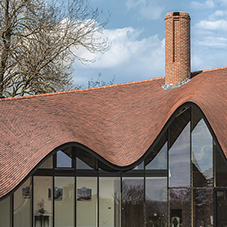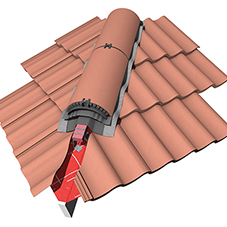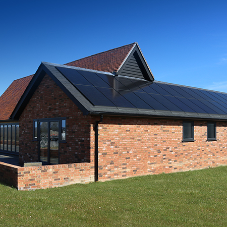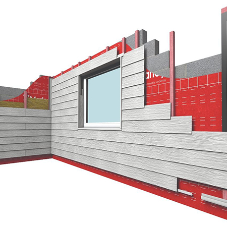A blog written by Marley
With a 31% carbon reduction target, the proposed changes to Part L in 2022 could lead to a five-fold increase in the number of new homes built with solar technologies, according to Solar Energy UK. But how is the retrofit market being affected by the UK’s drive towards net zero carbon emissions?
Stuart Elmes, CEO of Viridian Solar, which is now part of Marley, explains: “The retrofit market for solar has historically been driven by the Feed-in-Tariff scheme, which produced successive boom and bust cycles as consumers rushed to install solar PV before the next drop in subsidy. When the scheme finally ended in April 2019, it caused the retrofit market to scale back to a model based on home improvement and reducing energy use and carbon emissions.
“Now, in 2021, we are seeing a new set of market drivers, this time driven by government regulation rather than government hand-outs. This should create a more steady and sustainable retrofit market, without the highs and lows associated with some subsidy schemes. In England and Wales, there are already statutory minimum efficiency levels for private rented property and in Scotland, similar regulations are aimed at social housing. The required energy levels (EPC ratings) are readily achievable for all but the poorest performing properties. However, the intention is that these regulations will become tougher over time, to align with national environmental standards.
“Solar PV is a very convenient way to meet regulations like these because it requires relatively low disruption to the property and residents. The industry is already seeing large contracts for retrofit solar PV on social housing in Scotland, as a result of the Energy Efficiency in Scottish Social Housing regulations (EESSH).
“Indeed, social housing providers across the whole of the UK are increasingly referring to ‘No Regrets Refurbishment’, which means avoiding doing things and then having to come back and do more work to meet new energy efficiency targets. A classic example of this is roofing replacement. If a housing association is going to refurbish the roofs of properties and they need to engage tenants, appoint contractors and incur the expense of scaffolding, then why wouldn’t they install solar PV at the same time? We are seeing more and more social housing providers looking to combine low carbon retrofits into their asset management programmes.”
When it comes to private homeowners and occupiers, Stuart Nicholson, from Marley, says that many of the factors influencing new build buyers to choose properties with solar panels, are the same for those looking to retrofit solar PV:
“People have become much more conscious about reducing their own impacts on the environment, alongside the need to reduce high energy bills and this is a driver in the private retrofit market. However, an even more significant factor is going to be the Government’s ban on all new diesel and petrol cars from 2030. This will represent a huge increase in demand for electricity for charging vehicles at home over the coming years. Electricity is expensive, so on-site electricity generation will become increasingly appealing to home owners, as well as social housing providers.
“In addition, the cost to install solar panels has reduced dramatically over the past ten years, making it much more affordable and the potential savings and return on investment are very good. Prices are now around 75% cheaper than they were back in 2010 and the cost of battery storage is also becoming much cheaper, due to the automotive sector creating volume demand for use in electric vehicles.
“New integrated systems, like Marley SolarTile®, also make retrofitting very easy because they simply replace a section of roof tiles and have an easy push together design. Whereas previously consumers may have been put off by bulky on-roof systems, these discreet, integrated panels are incorporated into the roof surface, acting as a MCS 012 approved building material and becoming a seamless part of the roof design. This makes it easier to pass difficult planning conditions and they have even been approved for use on heritage sites and conservation projects.”
Indeed integrated systems are becoming more widely used on retrofit projects, particularly among local authorities and this is expected to follow suit in the private homes market, as the aesthetic, maintenance and installation benefits are realised.
Stuart Nicholson adds: “As well as the aesthetic benefits, integrated systems offer some significant advantages, including much easier maintenance. Unlike on-roof systems, both tiles and PV are installed together, which means there is no modification to the roof tiles, securing the manufacturer warranty and reducing the risk of breakages or cracks. Our integrated solar panels also prevent the problem of bird infestation and provide excellent weather-tightness, wind and fire resistance.”
For more information on Marley SolarTile®, or to view a demonstration installation video, please visit: www.marley.co.uk/solar
For more information on Viridian Solar, please visit: www.viridiansolar.co.uk
Regulations will drive a more sustainable Solar Retrofit Market [Blog]
| T | (01283) 722588 |
|---|---|
| E | info@marley.co.uk |
| W | Visit Marley's website |
| Lichfield Rd, Branston, Burton-on-Trent, Staffs, DE14 3HD |

![Regulations will drive a more sustainable Solar Retrofit Market [Blog]](/Solar image 1-file118649.jpg)
![Regulations will drive a more sustainable Solar Retrofit Market [Blog]](/3005-Fusion-Integrated-solar-PV-roofing-(C)Viridian-file118650.jpg)
![Regulations will drive a more sustainable Solar Retrofit Market [Blog]](/3008-Fusion-Solar-Roof-Integrated-(C)EMW-file118652.jpg)




